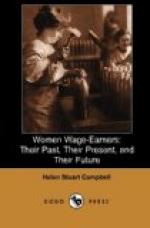The labor reports for the State of Missouri for 1889 and 1890 do not deal directly with the question of women wage-earners; but indirectly much light is thrown by the investigation, in that for 1889, into the cost of living and the home conditions of many miners and workers in general trades; while that for 1890 covers a wider field, and gives, with general conditions for all workers, detailed information as to many frauds practised upon them. The commissioner, Lee Merriweather, is so identified with the interests of the worker, whether man or woman, that a formal report from him on women wage-earners would have had especial value.
Last on the list of State reports comes an admirable one from Michigan, prepared by Labor Commissioner Henry A. Robinson, issued in February, 1892, which devotes nearly two hundred pages to women wage-earners, and gives careful statistics of 137 different trades and 378 occupations. Personal visits were made to 13,436 women and girls living in the most important manufacturing towns and cities of the State; and the blanks, which were prepared in the light of the experience gained by the work of other bureaus, contained 129 questions, classified as follows: social, 28; industrial, 12; hours of labor, 14; economic, 54; sanitary, 21; and seven other questions as to dress, societies, church attendance, with remarks and suggestions by the women workers. The result is a very minute knowledge of general conditions, the series of tables given being admirably prepared. In those on the hours of labor it is found that domestic service exacts the greatest number of hours; one class returning fourteen hours as the rule. In this lies a hint of the increasing objection to domestic service,—longer hours and less freedom being the chief counts against it. The final summary gives the average wage for the State as $4.86; the highest weekly average for women workers employed as teachers or in public positions being $10.78.
The remarks and suggestions of the women themselves are extraordinarily helpful. Outside the cities organization among them is unknown; but it is found that those trades which are organized furnish the best paid and most intelligent class of girls, who conceived at once the benefits of a labor bureau, and answered fully and promptly. The hours of work in all industries ranged from nine to ten, and the wage paid was found to be a little more than fifty per cent less than that of men engaged in the same work. A large proportion supported relatives, and general conditions as to living were of much the same order of comfort and discomfort as those given in other reports. The fact that this report is the latest on this subject, and more minute in detail than has before been possible, makes it invaluable to the student of social conditions; and it is entertaining reading, even for the average reader.
We come now to the final report, in some ways a summary of all,—that of the United States Labor Department at Washington, and the work for 1889.




